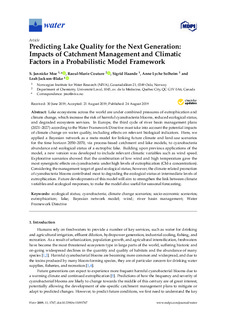| dc.contributor.author | Moe, S. Jannicke | |
| dc.contributor.author | Couture, Raoul-Marie | |
| dc.contributor.author | Haande, Sigrid | |
| dc.contributor.author | Solheim, Anne Lyche | |
| dc.contributor.author | Jackson-Blake, Leah Amber | |
| dc.date.accessioned | 2019-11-21T08:05:24Z | |
| dc.date.available | 2019-11-21T08:05:24Z | |
| dc.date.created | 2019-09-25T09:48:31Z | |
| dc.date.issued | 2019 | |
| dc.identifier.citation | Water. 2019, 11 (9), 1767. | nb_NO |
| dc.identifier.issn | 2073-4441 | |
| dc.identifier.uri | http://hdl.handle.net/11250/2629630 | |
| dc.description.abstract | Lake ecosystems across the world are under combined pressures of eutrophication and climate change, which increase the risk of harmful cyanobacteria blooms, reduced ecological status, and degraded ecosystem services. In Europe, the third cycle of river basin management plans (2021–2027) according to the Water Framework Directive must take into account the potential impacts of climate change on water quality, including effects on relevant biological indicators. Here, we applied a Bayesian network as a meta-model for linking future climate and land-use scenarios for the time horizon 2050–2070, via process-based catchment and lake models, to cyanobacteria abundance and ecological status of a eutrophic lake. Building upon previous applications of the model, a new version was developed to include relevant climatic variables such as wind speed. Explorative scenarios showed that the combination of low wind and high temperature gave the most synergistic effects on cyanobacteria under high levels of eutrophication (Chl-a concentration). Considering the management target of good ecological status, however, the climate-related promotion of cyanobacteria blooms contributed most to degrading the ecological status at intermediate levels of eutrophication. Future developments of this model will aim to strengthen the link between climate variables and ecological responses, to make the model also useful for seasonal forecasting. | nb_NO |
| dc.language.iso | eng | nb_NO |
| dc.publisher | MDPI | nb_NO |
| dc.rights | Navngivelse 4.0 Internasjonal | * |
| dc.rights.uri | http://creativecommons.org/licenses/by/4.0/deed.no | * |
| dc.title | Predicting Lake Quality for the Next Generation: Impacts of Catchment Management and Climatic Factors in a Probabilistic Model Framework | nb_NO |
| dc.type | Journal article | nb_NO |
| dc.type | Peer reviewed | nb_NO |
| dc.description.version | publishedVersion | nb_NO |
| dc.rights.holder | © 2019 by the authors | nb_NO |
| dc.source.pagenumber | 24 | nb_NO |
| dc.source.volume | 11 | nb_NO |
| dc.source.journal | Water | nb_NO |
| dc.source.issue | 9 | nb_NO |
| dc.identifier.doi | 10.3390/w11091767 | |
| dc.identifier.cristin | 1728675 | |
| dc.relation.project | Norges forskningsråd: 274208 | nb_NO |
| dc.relation.project | EC/FP7/603378 | nb_NO |
| cristin.unitcode | 7464,20,13,0 | |
| cristin.unitcode | 7464,30,19,0 | |
| cristin.unitcode | 7464,30,23,0 | |
| cristin.unitname | Økotoksikologi | |
| cristin.unitname | Ferskvannsøkologi | |
| cristin.unitname | Nedbørfeltprosesser | |
| cristin.ispublished | true | |
| cristin.fulltext | original | |
| cristin.qualitycode | 1 | |

